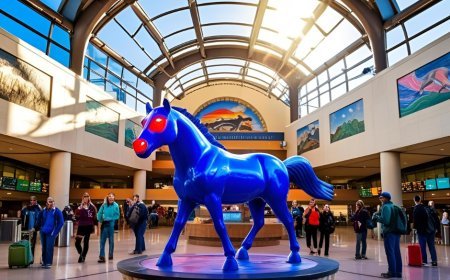The Floating Airship Hotel: A Visionary Dream of Luxury in the Skies
The Floating Airship Hotel was a visionary concept proposed by a German inventor in the early 20th century. This ambitious idea aimed to create a luxurious, floating hotel that would provide a grand travel experience above cities and landscapes. Despite its potential to revolutionize air travel, technological limitations and economic feasibility prevented it from becoming a reality. Today, with renewed interest in airships and sustainable aviation, could this concept finally take flight?

The Floating Airship Hotel: A Visionary Dream of Luxury in the Skies
Introduction
In the annals of aviation history, few concepts have captured the imagination quite like the Floating Airship Hotel. Proposed by a visionary German inventor in the early 20th century, this ambitious project promised an unparalleled travel experience—an opulent hotel floating serenely above bustling cities and breathtaking landscapes. Combining luxury with the latest aviation advancements, the idea was as grand as it was ahead of its time. Yet, despite its compelling allure, technological limitations rendered the concept unfeasible, relegating it to the realm of dreams.
This article delves into the origins, design, and ultimate fate of the Floating Airship Hotel, exploring the reasons why such a bold vision failed to take flight.
The Birth of an Ambitious Idea
The early 1900s was an era of immense technological optimism, particularly in aviation. While airplanes were still in their infancy, airships—also known as dirigibles—represented the pinnacle of aerial travel. The Germans, led by Count Ferdinand von Zeppelin, were at the forefront of airship innovation, envisioning new possibilities for passenger transport and luxury travel.
Against this backdrop, an unknown German inventor—whose name has since faded into obscurity—proposed a remarkable idea: an airborne hotel that would provide travelers with the comfort of a five-star accommodation while soaring through the skies. Unlike traditional airships designed for short journeys, this floating hotel aimed to provide extended stays, allowing guests to admire cityscapes, mountain ranges, and ocean horizons from the ultimate vantage point.
Design and Features: A Hotel in the Sky
The Floating Airship Hotel was envisioned as an enormous rigid airship, akin to the Zeppelins but far more luxurious. Its interior would have resembled that of a grand European hotel, complete with amenities to rival the finest establishments on the ground. Some of its key features included:
1. Lavish Accommodations
Each guest would enjoy a private suite outfitted with elegant furnishings, plush bedding, and panoramic windows offering stunning aerial views. These accommodations aimed to rival the finest hotel rooms of the era, ensuring both comfort and exclusivity.
2. Fine Dining and Social Halls
A grand dining hall would serve gourmet cuisine prepared by top chefs, while a central lounge provided a space for relaxation and socialization. Guests could sip champagne, listen to live music, or engage in lively conversation, much like they would on an elite ocean liner.
3. Open-Air Observation Decks
One of the most thrilling aspects of the design was the inclusion of open-air observation decks. These platforms would allow guests to step outside and experience the sensation of floating high above the earth, taking in breathtaking landscapes from an entirely new perspective.
4. Smooth and Silent Travel
Unlike the often turbulent experience of early airplanes, airships offered smooth and serene travel. The Floating Airship Hotel would glide effortlessly through the sky, providing an unparalleled sense of tranquility.
5. Extended Voyages
Unlike modern airplanes, which prioritize speed, the airship hotel was designed for leisurely travel. Journeys could last several days or even weeks, providing travelers with ample time to enjoy the scenery and amenities at a relaxed pace.
The Technological and Practical Challenges
Despite its grandeur, the Floating Airship Hotel faced several insurmountable obstacles that ultimately prevented it from becoming a reality.
1. Engineering Limitations
At the time, airship technology had not advanced to the point where a structure of such immense size could be safely and effectively built. Materials that could sustain prolonged flights while ensuring passenger safety simply did not exist.
2. Safety Concerns
Most early airships relied on hydrogen for lift, a highly flammable gas that posed significant risks. The infamous Hindenburg disaster of 1937 demonstrated the catastrophic consequences of hydrogen-fueled airships, reinforcing concerns about their safety.
3. Weather and Navigation Challenges
Unlike ocean liners, which could adjust course relatively easily, airships were at the mercy of unpredictable weather patterns. Strong winds, storms, and atmospheric changes made prolonged flights risky and impractical.
4. Economic Feasibility
Operating a luxury airship hotel would have been prohibitively expensive. The costs of construction, staffing, and fuel would have made ticket prices astronomically high, restricting access to only the wealthiest clientele.
The Decline of the Dream
As the aviation industry progressed, interest in airships began to wane. The development of fixed-wing aircraft, capable of faster and more reliable travel, rendered dirigibles obsolete. By the mid-20th century, the concept of a Floating Airship Hotel had been largely abandoned in favor of more practical modes of luxury travel, such as ocean liners and, eventually, private jets.
Furthermore, the Hindenburg disaster dealt a severe blow to the reputation of airships. Public confidence in lighter-than-air travel plummeted, and many investors who might have supported grandiose projects like the airship hotel withdrew their interest.
A Glimpse into the Future: Could the Concept Be Revived?
While the Floating Airship Hotel never materialized, modern technology has reignited interest in lighter-than-air travel. Advances in materials science, aerodynamics, and sustainable aviation fuel have made airships a more viable option for eco-friendly travel.
Several companies today are developing airship-based tourism, incorporating helium (a safer, non-flammable gas) and modern navigation systems. Hybrid Air Vehicles and LTA Research are among the firms working on new-generation airships, some of which incorporate luxury features reminiscent of the original airship hotel concept.
Could a modern Floating Airship Hotel become a reality in the 21st century? With climate change concerns and a growing interest in sustainable tourism, slow-travel airships could find a niche among luxury travelers seeking a unique experience. If safety, engineering, and economic challenges can be overcome, we may one day see a revival of this spectacular dream.
Conclusion
The Floating Airship Hotel remains one of the most fascinating unrealized concepts in aviation history. It represented an era of boundless imagination, where inventors dared to dream of possibilities far beyond the constraints of their time. Although the technology was not ready to support such an ambitious endeavor, its legacy endures as a testament to human ingenuity and the relentless pursuit of progress.
As we look to the future, perhaps this long-forgotten dream will take flight once again, proving that some ideas, no matter how ahead of their time, are never truly lost.
What's Your Reaction?








































